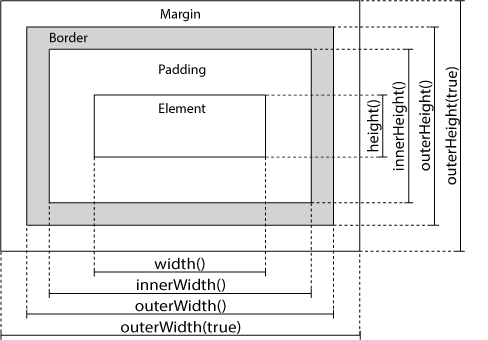Set/Get Content
- text("string") / text() - Sets/gets the text content of selected elements.
$("#homenav").click( function(){ alert($("#homenav").text());} ); - html("string") / html() - Sets/gets the content of selected elements (including outter/inner HTML tags).
$("#homenav").click( function(){ alert($("#homenav").html());} ); - val("string") / val() - Sets/gets the value of form fields. For example, $("#search").val() returns "input keywords" or the string modified by user in the input area.
<input type="text" id="search" value="input keywords">
Get Attributes
- attr() - Sets/gets the attribute value of some element.
$("button").click(function(){ alert($("a").attr("href")); });
$("#w3s").attr("href","http://www.w3schools.com/jquery");
Add New HTML Content
NOTE 1: append()/prepend() add content within the tag. E.g. <ol>prepend() is here<li>...</li>append() is here</ol>.NOTE 2: after()/before() add content outside the tag. E.g. before() is here<ol><li>...</li></ol>after() is here.
- append() - Add content at the end of the selected elements (within the selected tag).
- prepend() - Add content at the beginning of the selected elements (within the selected tag)
- after() - Add content after the selected elements (follow the selected end tag)
- before() - Add content before the selected elements (before the selected begin tag)
jQuery Manipulating CSS
- addClass() - Adds one or more CSS classes to the selected elements ==> change the rendering result.
- removeClass() - Removes one or more classes from the selected elements.
- toggleClass() - Toggles between adding/removing classes from the selected elements.
- css("property", "value") / css("property") - Set/get the style attribute.
- Set multiple css properties at once: css({"propertyname":"value", "propertyname":"value", ...});
jQuery HTML / CSS Methods
The table of jQuery DOM Manipulation methods. I add the last column "Usage", in which the usage to real case studies will be written in the future.
Method
|
Description
|
Usage
|
Adds one or
more class names to selected elements
|
Run-time add
CSS class
|
|
Inserts content
after selected elements
|
||
Inserts content
at the end of selected elements
|
||
Inserts HTML
elements at the end of selected elements
|
||
Sets or returns
attributes/values of selected elements
|
||
Inserts content
before selected elements
|
||
Makes a copy of
selected elements
|
||
Sets or returns
one or more style properties for selected elements
|
||
Removes
selected elements (keeps data and events)
|
||
Removes all
child nodes and content from selected elements
|
||
Checks if any
of the selected elements have a specified class name
|
||
Sets or returns
the height of selected elements
|
Run-time
block/content H measure
|
|
Sets or returns
the content of selected elements
|
||
Returns the
height of an element (includes padding, but not border)
|
||
Returns the
width of an element (includes padding, but not border)
|
||
Inserts HTML
elements after selected elements
|
||
Inserts HTML
elements before selected elements
|
||
Sets or returns
the offset coordinates for selected elements (relative to the document)
|
||
Returns the
first positioned parent element
|
||
Returns the
height of an element (includes padding and border)
|
||
Returns the
width of an element (includes padding and border)
|
||
Returns the
position (relative to the parent element) of an element
|
||
Inserts content
at the beginning of selected elements
|
||
Inserts HTML
elements at the beginning of selected elements
|
||
Sets or returns
properties/values of selected elements
|
||
Removes the
selected elements (including data and events)
|
||
Removes one or
more attributes from selected elements
|
||
Removes one or
more classes from selected elements
|
Run-time remove
CSS class
|
|
Removes a
property set by the prop() method
|
||
Replaces
selected elements with new HTML elements
|
||
Replaces selected
elements with new content
|
||
Sets or returns
the horizontal scrollbar position of selected elements
|
||
Sets or returns
the vertical scrollbar position of selected elements
|
||
Sets or returns
the text content of selected elements
|
||
Toggles between
adding/removing one or more classes from selected elements
|
On/Off effects
|
|
Removes the
parent element of the selected elements
|
||
Sets or returns
the value attribute of the selected elements (for form elements)
|
||
Sets or returns
the width of selected elements
|
Run-time
block/content W measure
|
|
Wraps HTML
element(s) around each selected element
|
||
Wraps HTML
element(s) around all selected elements
|
||
Wraps HTML
element(s) around the content of each selected element
|
jQuery Dimension Methods
jQuery methods for working with dimensions:- width() / height(): content range
- innerWidth() / innerHeight(): content + paddings
- outerWidth(true) / outerHeight(true): content + paddings + border + margin(true)
 |
| http://www.w3schools.com/jquery/jquery_dimensions.asp |
jQuery Traversing
Using jQuery traversing methods to "move through" elements within the HTML DOM tree, or "find / select" HTML elements based on relative positions to other elements. Then, HTML rendering or CSS effects can be dynamically changed by modifying those elements with JS codes. |
| HTML Elements is the DOM tree, a node represents a block of content or area. |
- move up (ancestors): parent(), parents(), parentsUntil(). E.g. "$("span").parents();" returns all ancestors of all <span> elements, "$("span").parents("ul");" returns all ancestors of all <span> elements that are <ul> elements, "$("span").parentsUntil("div");" moves up until <div> found.
- move down (descendants): children(), find(). E.g. "$("div").children();" returns all elements that are direct children of each <div> elements, "$("div").children("p.1");" returns all <p> elements with the class name "1", that are direct children of <div>.
- move sideways (siblings): siblings(), next(), nextAll(), nextUntil(), prev(), prevAll(), prevUntil().
- filtering methods: first(), last() and eq(). "$("p").eq(1);" returns the second <p> element (index number 1). The index numbers start at 0.
No comments :
Post a Comment